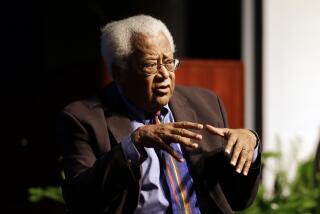Splicing Film With Activism
St. Clair Bourne has written, directed and produced more than 45 documentaries since becoming an independent filmmaker in 1968. His works have essayed the civil rights movement, the Black Panther Party, race relations and the African American church; his portraits of key cultural figures include acclaimed biographies of poet Langston Hughes, actor-activist Paul Robeson, poet Amiri Baraka and filmmakers Gordon Parks and Spike Lee. After decades as a quintessential New York progressive, Bourne moved to Los Angeles in 2002 for a go at feature films, but true to his nature, he also founded 4th Monday, an alternative film salon, and finds himself midway through a documentary on novelist and Watts native Walter Mosley. The longtime lefty also has been included on a list of filmmakers selected by the Corporation for Public Broadcasting for the PBS series “America at a Crossroads.” We recently took stock.
Is there a common element in your choice of subjects?
These people and organizations tend to be at the cutting edge of social change. I grew up and began my career in conditions that helped me become a filmmaker. The Robeson film [for PBS’ “American Masters”] does what I like to do--explore progressive social change, look at the individuals with flaws, talk about how they are affected as human beings participating in the movements of the time.
How did the milieu in which you were brought up shape your work?
I came out of the ‘60s. That was the era where the society was changing rapidly. I got access to being a filmmaker not only because I worked hard, but because black people were protesting their conditions. And they were protesting it with bricks as well as pencils. And the power structure opened up.
You started a progressive screening group outside the Hollywood-Westside movie industry orbit. Why?
We meet every fourth Monday of the month in [director] John Singleton’s screening room in Leimert Park. Leimert Park is sort of the black Greenwich Village of L.A. We look at films that are a little more political and different stylistically. The only way we can change is to educate ourselves, and get a couple [of films] out there. If the audience is there, Hollywood will follow.
Are African American filmmakers underrepresented in the movie industry?
I don’t think that there is as much underrepresentation as people think; it’s just that the black people are doing the same things that white people are doing. There are a lot more black writers writing in Hollywood, but they are writing the Hollywood model. I am concerned about whether black people work in the Hollywood system. But I am more concerned about, “Will they make a difference, quality-wise?” Me and my generation affected the way black people were viewed in the documentary field. That’s happening a little, but not as much as it should.
What draws you to Walter Mosley as a subject?
Los Angeles has varied ethnic communities. It has history that a lot of people don’t know about, and Mosley explores that in his work. Walter himself is a unique, L.A.-type guy. He grew up in Watts, he had a Jewish mother, he had a black father who came from Texas, where a lot of [black Angelenos] came from. If you read his books, it’s almost like an L.A. history lesson. He [now] lives in New York. But most of the film is going to be set in Los Angeles, because frankly, right now, it’s more interesting.
If you could make a documentary on L.A., what kind of film would it be?
L.A. journalist John Mitchell [an editor at The Times] and I have just completed a treatment called “Between Two Fires,” and it’s a history of L.A. from 1965 [and the Watts riots] to 1992 [and the Rodney King riots]. Mitchell says L.A. became a world-class city during that period. The public face of that is [the late Mayor Tom] Bradley, not really Bradley, but people underneath and around him, showing the social forces of that time.
More to Read
Only good movies
Get the Indie Focus newsletter, Mark Olsen's weekly guide to the world of cinema.
You may occasionally receive promotional content from the Los Angeles Times.










